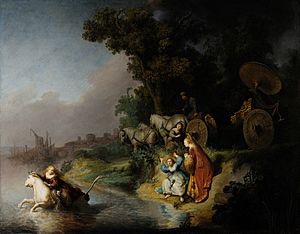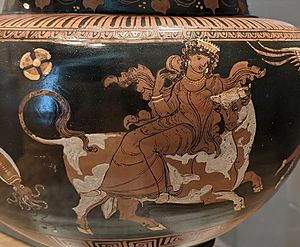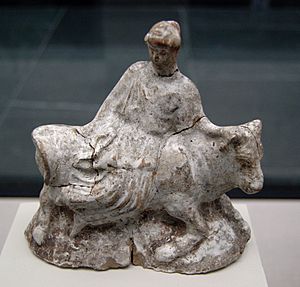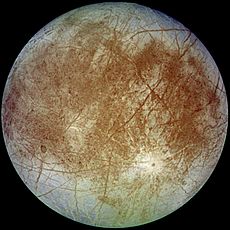Europa (consort of Zeus) facts for kids
Quick facts for kids Europa |
|
|---|---|

Statue of Europa representing Europe at Palazzo Ferreria
|
|
| Abode | Crete |
| Personal information | |
| Born | Tyre, Phoenicia, (modern-day Lebanon) |
| Consort | Asterion, Zeus |
| Children | Minos, Rhadamanthys, Sarpedon, Crete, Alagonia, Carnus |
| Parents | Agenor with either Telephassa or Argiope; alternatively Phoenix and Perimede |
| Siblings | Cadmus, Cilix, Phoenix |
In Greek mythology, Europa was a princess from Phoenicia, a land in the ancient world. She was the mother of Minos, who became a famous king of Crete. Many people believe the continent of Europe was named after her.
The story of Europa being carried away by the god Zeus, who had turned into a bull, is a very old tale from Crete. Many myths about Zeus falling in love actually came from older stories about his marriages to goddesses. The story of Europa is one of these.
We first read about Europa in the Iliad, a famous Greek poem from around 800 BC. Another early mention is in a piece of writing called the Catalogue of Women. The oldest painting of Europa on a vase is from the mid-600s BC.
Contents
Europa's Family and Home
Europa's family details can be a bit different depending on the old stories you read. But everyone agrees she was from Phoenicia. Her family line came from Io, a mythical nymph (a nature spirit) who Zeus loved and turned into a cow.
Europa is usually said to be the daughter of Agenor, the King of Tyre in Phoenicia. Some stories say her mother was Queen Telephassa, while others say it was Argiope. A few stories, like the Iliad, say she was the daughter of Agenor's son, Phoenix.
After Europa arrived in Crete, she had three sons with Zeus: Minos, Rhadamanthus, and Sarpedon. When Minos and Rhadamanthus died, they became judges of the Underworld. Europa later married Asterion, the king of Crete. She became the mother (or stepmother) of his daughter, Crete.
The Myth of Europa and the Bull



According to ancient myths, Zeus was very interested in Europa. He decided to take her to Crete. To do this, he changed himself into a gentle, white bull. He then joined her father's herds of cattle.
One day, Europa and her friends were picking flowers. She saw the beautiful white bull. She gently touched its sides and eventually climbed onto its back. This was Zeus's chance! He immediately ran to the sea and swam across to the island of Crete, with Europa still on his back.
Once they arrived in Crete, Zeus showed Europa his true form as the mighty god. Europa then became the first queen of Crete. Zeus gave her special gifts. These included a beautiful necklace made by Hephaestus (the god of craftsmanship). He also gave her Talos, a giant bronze robot guard, and Laelaps, a magical hound dog that always caught whatever it chased. Finally, he gave her a javelin that never missed its target.
Later, Zeus placed the shape of the white bull in the stars. This became the constellation we know today as Taurus. This bull is different from the Cretan Bull, which was a monster that fathered the Minotaur. The hero Heracles later captured the Cretan Bull. The Romans also told this story, but they used their god Jupiter instead of Zeus.
Where Europa's Name is Used
The Continent of Europe
The name Europe is used for the continent. Ancient Greek geographers like Strabo first used it to describe a part of Thrace. Later, during the Roman Empire, it became the name of a Roman province.
The word Eurōpē comes from the Greek language. Many languages around the world use a similar word for Europe. This includes Romance languages, Germanic languages, Slavic languages, and many others.
In the 700s, the name "Europa" started to be used for the empire of Charlemagne. This is how it became the name for the continent we know today. The word Europenses was first used in 754 AD to describe the Christian people of the western part of the continent. This was after a battle against Muslim forces.
The European Union uses Europa as a symbol of unity for all of Europe. For example, their main website is named after her. She is also shown on the Greek €2 coin and on some special gold and silver coins. Her name has appeared on postage stamps celebrating the Council of Europe since 1956. The second series of euro banknotes is called the Europa Series. It features her image in the watermark and hologram.
The Chemical Element Europium
The metal europium is a rare-earth element. It was named in 1901 after the continent of Europe.
Jupiter's Moon Europa
When the telescope was invented, people discovered that the planet Jupiter has many moons. These moons were named after the god Jupiter's lovers and other characters from mythology. The smallest of Jupiter's four largest moons, called the Galilean moons, was named after Europa.
Images for kids
-
The ancient city of Tyre, Lebanon, believed to be Europa's birthplace.
See also
 In Spanish: Europa (mitología) para niños
In Spanish: Europa (mitología) para niños





